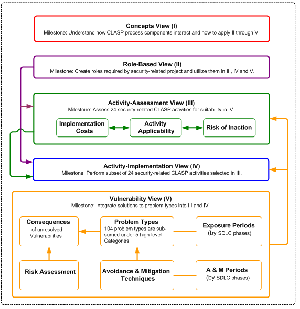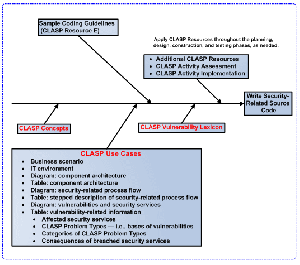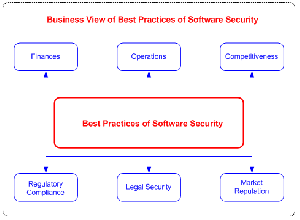This site is the archived OWASP Foundation Wiki and is no longer accepting Account Requests.
To view the new OWASP Foundation website, please visit https://owasp.org
CLASP Concepts
Concepts View
CLASP is the outgrowth of years of extensive field work in which system resources of many development lifecycles were methodically decomposed in order to create a comprehensive set of security requirements. These resulting requirements form the basis of CLASP’s best practices which allow organizations to systematically address vulnerabilities that, if exploited, can result in the failure of basic security services — e.g., confidentiality, authentication, and access control.
Adaptability of CLASP to Existing Development Processes
CLASP is designed to allow you to easily integrate its security-related activities into your existing application development processes. Each CLASP activity is divided into discrete process components and linked to one or more specific project roles. In this way, CLASP provides guidance to project participants — e.g., project managers, security auditors, developers, architects, testers, and others — that is easy to adopt to their way of working; this results in incremental improvements to security that are easily achievable, repeatable, and measurable.
CLASP Vulnerability Lexicon
CLASP also contains a comprehensive Vulnerability Lexicon that helps development teams avoid/remediate specific designing/coding errors that can lead to exploitable security services. The basis of this Lexicon is a highly flexible taxonomy — i.e., classification structure — that enables development teams to quickly locate Lexicon information from many perspectives: e.g., problem types (i.e., basic causes of vulnerabilities); categories of problem types; exposure periods; avoidance and mitigation periods; consequences of exploited vulnerabilities; affected platforms and programming languages; risk assessment.
Automated Analysis Tool
Much of the information in the CLASP Vulnerability Lexicon can be enforced through use of automated tools using techniques of static analysis of source code.
Overview of CLASP Process
This section provides an overview of CLASP’s structure and of the dependencies between the CLASP process components and is organized as follows:
- CLASP Views
- CLASP Resources
- Vulnerability Use Cases
CLASP Views
The CLASP process is presented through five high-level perspectives called CLASP Views. These views are broken down into activities which in turn contain process components. This top-down organization by View > Activity > Process Component allows you to quickly understand the CLASP process, how CLASP pieces interact, and how to apply them to your specific software development lifecycle. These are the CLASP Views:
- Concepts View
- Role-Based View
- Activity-Assessment View
- Activity-Implementation View
- Vulnerability View
See figure 1.
CLASP Resources
The CLASP process supports planning, implementing and performing security-related software development activities. The CLASP Resources provide access to artifacts that are especially useful if your project is using tools to help automate CLASP process pieces. This table lists the name and location of CLASP Resources delivered with CLASP and indicates which CLASP Views they can support:
| CLASP Resources | Location |
|---|---|
| Basic Principles in Application Security (all Views) | Resource A |
| Example of Basic Principle: Input Validation (all Views) | Resource B |
| Example of Basic-Principle Violation: Penetrate-and-Patch Model (all Views) | Resource C |
| Core Security Services (all Views; especially III) | Resource D |
| Sample Coding Guideline Worksheets (Views II, III & IV)
Note: Each worksheet can be pasted into a MS Word document. |
Resource E |
| System Assessment Worksheets (Views III & IV)
Note: Each worksheet can be pasted into a MS Word document. |
Resource F |
| Sample Road Map: Legacy Projects (View III) | Resource G1 |
| Sample Road Map: New-Start Projects (View III) | Resource G2 |
| Creating the Process Engineering Plan (View III) | Resource H |
| Forming the Process Engineering Team (View III) | Resource I |
| Glossary of Security Terms (all Views) | Resource J |
Vulnerability Use Cases
The CLASP Vulnerability Use Cases depict conditions under which security services can become vulnera¬ble in software applications. The Use Cases provide CLASP users with easy-to-understand, specific exam¬ples of the cause-and-effect relationship between security-unaware design/source coding and possible resulting vulnerabilities in basic security services — e.g., authentication authorization, confidentiality, avail¬ability, accountability, and non-repudiation. The CLASP Vulnerability Use Cases are based on the following common component architectures:
- Monolithic UNIX
- Monolithic mainframe
- Distributed architecture (HTTP[S] & TCP/IP)
It is recommended to understand the CLASP Use Cases as a bridge from the Concepts View of CLASP to the Vulnerability Lexicon (in the Vulnerability View) since they provide specific examples of security ser¬vices becoming vulnerable in software applications See figure 2.
CLASP Best Practices
If security vulnerabilities built into your applications’ source code survive into production, they can become corporate liabilities with broad and severe business impact on your organization. In view of the conse¬quences of exploited security vulnerabilities, there is no reasonable alternative to using best practices of application security as early as possible in — and throughout — your software development lifecycle. See figure 3.
To be effective, best practices of software application security must have a reliable process to guide a development team in creating and deploying a software application that is as resistant as possible to secu¬rity vulnerabilities. Within a software development project, the CLASP Best Practices are the basis of all security-related soft¬ware development activities — whether planning, designing or implementing — including the use of all tools and techniques that support CLASP. These are the CLASP Best Practices:
- Institute awareness programs
- Perform application assessments
- Capture security requirements
- Implement secure development practices
- Build vulnerability remediation procedures
- Define and monitor metrics
- Publish operational security guidelines
Institute awareness programs
Essential security concepts and techniques may be foreign to your organization’s software developers and others involved in application development and deployment. So it is imperative at the outset to educate everyone involved. It is critical that project managers — as the driving force behind most application development or upgrade projects — consider security to be an important project goal, both through training and accountability. Awareness programs can be readily implemented, using external expert resources, as appropriate, and deliver a high return by helping to ensure that other activities promoting secure software will be implemented effectively.
Perform application assessments
While it’s true that you cannot test security into an application, application testing and assessments should still be a central component of your overall security strategy. Assessments — particularly automated tests — can find security problems not detected during code or implementation reviews, find security risks introduced by the operational environment, and act as a defense-in-depth mechanism by catching failures in design, specification or implementation. Test and assessment functions are typically owned by a test analyst or by the QA organization but can span the entire life cycle.
Capture security requirements
Ensure that security requirements have the same level of “citizenship” as all other “must haves.” It’s easy for application architects and project managers to focus on functionality when defining requirements, since they support the greater purpose of the application to deliver value to the organization. Security considerations can easily go by the wayside. So it is crucial that security requirements be an explicit part of any application development effort. Among the factors to be considered:
- An understanding of how applications will be used, and how they might be misused or attacked.
- The assets (data and services) that the application will access or provide, and what level of protection is appropriate given your organization’s appetite for risk, regulations you are subject to, and the potential impact on your reputation should an application be exploited.
- The architecture of the application and probable attack vectors.
- Potential compensating controls, and their cost and effectiveness.
Implement secure development practices
Defined security activities, artifacts, guidelines and continuous reinforcement should become part of your organization’s overall culture.
Build vulnerability remediation procedures
It is especially important in the context of application updates and enhancements to define which steps will be taken to identify, assess, prioritize and remediate vulnerabilities.
Define and monitor metrics
You cannot manage what you cannot measure. Unfortunately, implementing an effective metrics monitoring effort can be a difficult undertaking. Despite this, metrics are an essential element of your overall application security effort. They are crucial in assessing the current security posture of your organization, help focus attention on the most critical vulnerabilities, and reveal how well — or poorly — your investments in improved security are performing.
Publish operational security guidelines
Security does not end when an application is completed and deployed in a production environment. Making the most out of existing network and operational security investments requires that you inform and educate those tasked with monitoring and managing the security of running systems with advice and guidance on the security requirements your application demands, and how best to make use of the capabilities you’ve built into your application.


